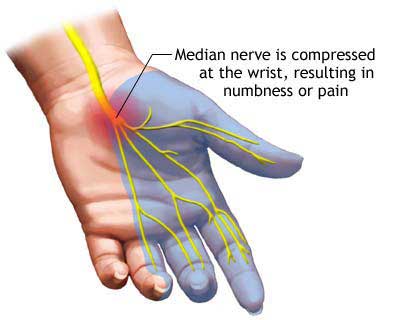The Complete Guide to The Best Carpal Tunnel Syndrome Treatment in Toronto: Diagnosis, Causes, and Chiropractic Care
If you’re here, chances are you’re dealing with persistent wrist or hand pain that’s affecting your everyday activities. Whether it’s difficulty typing, gripping objects, or sleeping through the night, these symptoms could be pointing to carpal tunnel syndrome (CTS). This blog will cover everything you need to know about CTS. We will cover how to diagnose it, the most effective ways of addressing it, and the Core Problem behind it. And if you’re in Toronto searching for the best carpal tunnel syndrome treatment in Toronto, this guide is for you.
What is Carpal Tunnel Syndrome | Carpal Tunnel Syndrome Treatment In Toronto
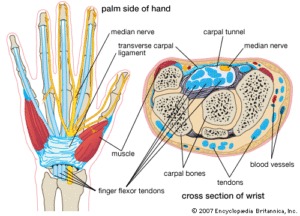
Carpal tunnel syndrome is a common condition that affects the wrist and hand, often causing pain, tingling, numbness, and weakness. It occurs when the median nerve gets compressed or pinched. This happens when it passes through a narrow passage called the carpal tunnel in your wrist.
Think of the carpal tunnel as a busy highway, with many tendons, blood vessels, and the median nerve passing through. If something causes this tunnel to become more crowded, it puts pressure on the nerve, leading to the classic symptoms of carpal tunnel syndrome. Sometimes, the nerve is also under stress above the wrist – say in the neck, chest, or arm and is already irritated when it reaches the tunnel. The best carpal tunnel syndrome treatment in Toronto should also assess these areas.
Understanding the Anatomy of Carpal Tunnel Syndrome
Understanding the Anatomy of the Wrist

The carpal tunnel is formed by bones (carpal bones) at the base of the wrist and a strong band of connective tissue (the transverse carpal ligament) across the top. This tunnel is quite small, which means that even slight changes—like swelling of nearby tendons—can easily compress the median nerve.
The median nerve is responsible for sensation in your thumb, index finger, middle finger, and part of your ring finger. It also controls the muscles at the base of your thumb. When this nerve is compressed, you experience pain, tingling, or numbness in these areas. Left untreated, carpal tunnel syndrome can lead to permanent nerve damage and loss of hand function.
Advanced cases of CTS can cause muscle wasting in the thumb. Pain is not always present in the wrist.
Understanding the Anatomy of the Median Nerve
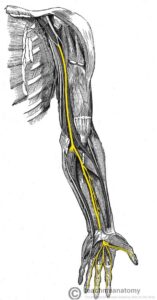
The entire pathway of the median nerve and the branches that contribute to it must be assessed in all cases of CTS. It is common for the median nerve to be compressed or irritated in the neck, shoulder, or arm as it travels towards the carpal tunnel. In these cases, neuropraxia, a type of subtle nerve injury, can make any compression of the median nerve in the carpal tunnel much more severe.
We find the median nerve to most often be irritated as part of the brachial plexus, underneath the pectoralis minor, in the medial intermuscular septum of the arm (between the biceps and triceps) or underneath the pronator teres in the forearm.
To get the best carpal tunnel syndrome treatment in Toronto, ensure your professional is checking these potential points of nerve entrapment.
What Causes Carpal Tunnel Syndrome?
Carpal tunnel syndrome is a multifactorial condition—there’s rarely one singular cause, but rather a combination of factors that increase the likelihood of developing it. We find that pregnancy and office work are the most common causes of this condition for our practice members.
1. Repetitive Hand Movements
One of the most well-known causes of CTS is repetitive motion, particularly involving the wrist. Whether it’s long hours typing on a computer, using tools that involve a lot of wrist flexion (like in construction work), or repetitive actions like playing musical instruments, these movements can irritate the tendons passing through the carpal tunnel, causing them to swell and compress the median nerve.

2. Wrist Position
Your wrist’s posture matters a lot. Keeping the wrist in a flexed or extended position for prolonged periods increases pressure on the median nerve. For example, people who sleep with their wrists bent or those who work with their wrists constantly extended or flexed may experience symptoms sooner. A wrist brace can be helpful if this is an underlying cause.
3. Inflammatory Conditions
Conditions like rheumatoid arthritis or diabetes can cause inflammation in the body, including around the wrist, leading to CTS. Similarly, fluid retention, often seen during pregnancy or from certain medical conditions, can also increase pressure in the carpal tunnel.
4. Injury or Trauma
A fracture or dislocation in the wrist can directly damage the structures of the carpal tunnel, potentially leading to chronic compression of the median nerve.
5. Genetics
Sometimes, the size of the carpal tunnel itself is hereditary. Individuals with smaller carpal tunnels are more susceptible to developing CTS, even without external factors like repetitive strain.
6. Age and Gender
Women are more likely to develop CTS, partly because they tend to have smaller carpal tunnels. The likelihood of developing the condition also increases with age, particularly for those over 50.
How is Carpal Tunnel Syndrome Diagnosed?
If you’re experiencing wrist pain, numbness, or weakness, it’s crucial to get a proper diagnosis to confirm the diagnosis. Carpal tunnel syndrome is often mistaken for cubital tunnel syndrome, radial tunnel syndrome, or nerve irritation in the forearm, shoulder or neck. A healthcare professional—such as a chiropractor or primary care doctor—can diagnose CTS based on your symptoms, physical exams, and sometimes additional tests.
1. Symptom Review
A detailed review of your symptoms is the first step. Common symptoms of CTS include:
- Numbness or tingling in the thumb, index, middle, and part of the ring finger
- Hand weakness, particularly when trying to grip objects
- Wrist pain that may extend into the forearm
- Symptoms that worsen at night or after repetitive activities
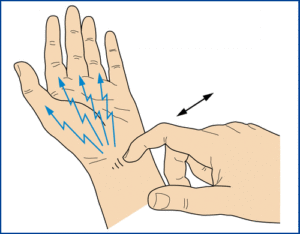
2. Physical Examination
During a physical exam, your doctor may perform specific tests, like:
- Phalen’s Test: Holding your wrists in a flexed position to see if it reproduces symptoms.
- Tinel’s Sign: Lightly tapping over the median nerve at the wrist to see if it causes tingling or pain in the fingers.
- Grip Strength Tests: Assessing muscle strength in your hand and fingers.
3. Diagnostic Imaging
In some cases, an ultrasound or MRI might be used to visualize the structures in the carpal tunnel or to rule out other conditions. This is rarely needed as CTS is primarily a clinical diagnosis.
4. Nerve Conduction Study (NCS)
This test measures the speed at which electrical impulses move through the median nerve. If the nerve is compressed, it will conduct signals more slowly, confirming a diagnosis of CTS.
Best Carpal Tunnel Syndrome Treatment in Toronto: Chiropractic Care
If you’re dealing with carpal tunnel syndrome, you’re probably wondering: what’s the best treatment available? Luckily, chiropractic care can offer a safe, effective, and non-invasive solution to relieve symptoms and address the root cause of the condition. Providing the best carpal tunnel syndrome treatment in Toronto should include manual therapy to correct any underlying problems with the spine, muscles or nerves causing CTS. It should also include a Corrective Exercise plan to eliminate/reduce any lifestyle-related factors.
How Chiropractic Care Can Help
Chiropractic treatment focuses on restoring optimal function to your body’s musculoskeletal system, including the spine, joints, muscles, and nerves. For carpal tunnel syndrome, this approach helps by reducing pressure on the median nerve, improving mobility, and promoting healing.
1. Wrist and Hand Adjustments
Chiropractors can perform gentle adjustments/corrections on the wrist, hand, and elbow to alleviate the pressure in the carpal tunnel. This helps to reduce inflammation and improve the function of the affected joints.
The goal of these corrections is to realign the bones in your wrist and relieve any irritation on the median nerve. Over time, this can lead to decreased symptoms and improved hand function.
2. Spinal Corrections
It may seem surprising, but chiropractic care for CTS doesn’t just involve treating the wrist. Many chiropractors focus on spinal adjustments—particularly in the neck—since the nerves that control the arms and hands originate from the cervical spine.
Misalignments in the upper spine can contribute to nerve dysfunction, exacerbating carpal tunnel symptoms. By correcting spinal misalignments, chiropractors help restore proper nerve flow and reduce inflammation.
3. Soft Tissue Therapy/Acupuncture
Soft tissue therapy is another cornerstone of chiropractic treatment for CTS. This involves addressing muscle tightness, tension, and trigger points in the forearm, wrist, and hand. We primarily use electroacupuncture as it is the most direct form of therapy to address a nerve issue.
4. Corrective Exercises
A skilled chiropractor will prescribe specific stretching and strengthening exercises that target the muscles in your hand, wrist, and forearm. These exercises aim to improve the flexibility of the muscles and tendons, reducing the strain on the median nerve.
For instance, wrist flexor stretches, median nerve gliding exercises and strengthening of the intrinsic muscles of the hand can play a crucial role in both symptom relief and prevention of future flare-ups.
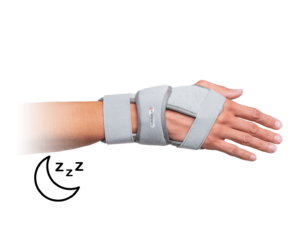
5. Lifestyle Modifications
Chiropractors also focus on ergonomic advice and lifestyle changes. If your work or daily activities involve repetitive motions that contribute to the development of carpal tunnel syndrome, your chiropractor will work with you to modify these activities. Whether it’s adjusting your desk setup, teaching proper posture, or recommending wrist supports, these modifications can prevent further strain on the carpal tunnel.
Why Chiropractic Care is the Best Carpal Tunnel Syndrome Treatment in Toronto
When it comes to carpal tunnel syndrome, chiropractic care offers a holistic, non-invasive alternative to medications or surgery. Unlike more invasive treatments, chiropractic adjustments focus on the root cause of the condition, rather than merely masking the symptoms. By addressing both the wrist and the spine, chiropractic care helps restore proper nerve function, reduce pain, and prevent future complications.
Chiropractic care is also tailored to each individual. Your chiropractor will create a personalized treatment plan that considers your specific symptoms, lifestyle, and goals, ensuring that you get the best possible outcome.
If you’re looking for the best carpal tunnel syndrome treatment in Toronto, chiropractic care offers a safe, effective, and long-term solution. The combination of adjustments, soft tissue therapy, and therapeutic exercises not only alleviates symptoms but promotes overall wellness and prevents future issues.
Conclusion
Carpal tunnel syndrome is a common but highly treatable condition. By understanding the causes and early symptoms, you can seek proper care before the problem worsens. Chiropractic care is an effective, non-invasive treatment option that addresses the underlying causes of CTS and offers a natural path to recovery. If you’re searching for the best carpal tunnel syndrome treatment in

